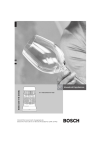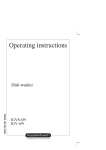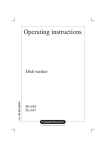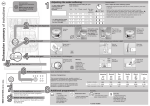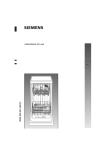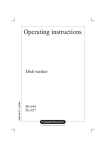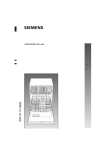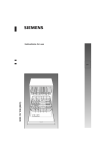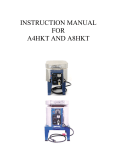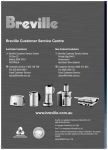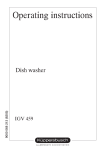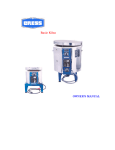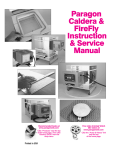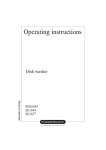Download Operating instructions
Transcript
en Index Safety instructions . . . . . . . . . . . . . Getting to know your appliance . . Before using your appliance for the first time . . . . . . . . . . . . . . . . Filling in the Salt . . . . . . . . . . . . . . . Setting up the water softener . . . . Filling with rinse aid . . . . . . . . . . . . Unsuitable dishes . . . . . . . . . . . . . Arranging crockery, glasses, etc. in the dishwasher . . . . . . . . . . Detergents . . . . . . . . . . . . . . . . . . . 4 6 7 8 9 10 11 12 15 Opening and closing the door . . . serve@Home * . . . . . . . . . . . . . . . . Adjusting the appliance . . . . . . . . . auto 3in1 . . . . . . . . . . . . . . . . . . . . . Programme overview . . . . . . . . . . Selecting options/standard settings Maintenance and care . . . . . . . . . . Fault finding . . . . . . . . . . . . . . . . . . Customer Service . . . . . . . . . . . . . Notes . . . . . . . . . . . . . . . . . . . . . . . . Installation . . . . . . . . . . . . . . . . . . . . 17 18 19 19 21 22 28 30 33 33 34 en Safety instructions Delivery Immediately check the packaging and dishwasher for any damage which may have been caused in transit. Do not use a damaged appliance, but consult your supplier. Please dispose of packaging material properly. The corrugated cardboard consists mainly of waste paper. The polystyrene moulded parts have been foamed without any CFCs. The polyethylene film (PE) consists partly of secondary raw material. The wooden frames (if fitted) are made of residual wood and are untreated. The hoops (if fitted) consist of polypropylene (PP). 4 Installation Install and connect the appliance according to the installation and assembly instructions. The dishwasher must NOT be connected to the power supply during installation. Ensure that the protective conductor system of the domestic electricity supply has been installed correctly. Electrical connection conditions must correspond with the specifications on the rating plate of the dishwasher. In order for your dishwasher to become serve@Home capable, you will need a special accessory, the System Interface (available from your specialist supplier). Please follow the enclosed installation instructions, and install the system interface in the chamber located at the front of the dishwasher. Built-under and built-in appliances should always be installed under a continuous work surface which is attached to the adjacent cupboards, in order to ensure that the appliance is entirely stable. After the appliance has been installed, the mains plug should still be easily accessible. Not on all models: The plastic housing on the water input contains an electrically operated valve. The connecting wires are inside the inlet hose. Do not cut through this hose and do not immerse the plastic housing in water. en Warning For safety reasons, if the appliance is not fitted in a recess, thereby making a side wall accessible, the door hinge area should be covered at the side. (Risk of injury) Covers are available as optional accessories from customer services or specialist stores. In daily use Warning Knives and other utensils with sharp points must be placed in the baskets either flat or with the points downwards. Use the dishwasher only in the household and only for its designed purpose, i.e. for washing domestic dishes. Do not lean or sit on the open door. The appliance could tip. The water in the appliance is not drinking water. Do not add any solvents to the washing chamber. Danger of explosion! Open the door carefully when the programme is still running. Water could spray out of the appliance. Read and observe the safety information and instructions for use on the packaging for cleaning and rinsing agents. Children in the household Do not let infants play or operate the dishwasher. Keep cleaning and rinsing agents out of the reach of infants. Keep infants away from the open dishwasher. It could contain residue of the cleaning agent. To prevent injuries, e.g. caused by stumbling, open the dishwasher only briefly in order to load and unload the dishwasher. If a fault occurs Repairs or other work on the dishwasher should only be carried out by a qualified specialist. The dishwasher must be disconnected from the electricity supply before any repairs or other work are started. Pull the mains plug out of the wall socket or switch off at the fuse box. Grasp the plug to remove it from the socket; do not tug on the cable. Turn the water off at the tap. When disposing of old appliances Appliances that have reached the end of their service life should be rendered inoperable in order to exclude the possibility of subsequent accidents. Pull the mains plug out of the wall socket, cut through the connecting cable and disable the door lock. Take the appliance to a designated waste disposal centre. Warning Children could get locked in the appliance (risk of suffocation) or get stuck in other positions. Therefore: Remove the mains plug, cut the mains wire and set aside. Damage the door lock so that the door can no longer be closed. 5 en Getting to know your appliance Diagrams of the control panel and the interior of the appliance can be found in the envelope at the front. Individual positions are referred to in the text. Control panel 1 2 3 4 5 6 Main switch Button M/OK: Select options, store (changed) value Buttons – and +: Select programmes and settings This display gives optical character information on the programmes, options, and settings to be selected as well as on the available actions. Start Button: Start programme Door Opener The luminous arrows indicate whether you are able to select among other options using – or + 3 . This dishwasher is equipped with touch buttons. A gentle touch starts the function. Always keep the user interface clean and free of grease in order to prevent malfunctions. Use a dry or lightly moistened cloth only, do not use scouring or abrasive detergents. 6 Appliance interior 20 21 22 23 24 25 26 27 28 29 30 31 32 33 Upper utensils basket Additional cutlery basket * for the top basket Additional cup rack * Upper spray arm Lower spray arm Dispenser for salt Filters Cutlery basket Lower utensils basket Lock Dispenser for rinse aid with refill display Detergent dispenser Optical limescale sensor Rating plate * some models en Before using your appliance for the first time Before you can use your appliance for the first time, you must select the language. When the appliance has been switched on, the following display is output: M OK – < DE EN FR NL IT EL > + The language abbreviation “DE” for “Deutsch” (German) is flashing. If you want to select a different language, press – or + 3 repeatedly until the abbreviation of your desired language flashes. Confirm the language selection by pressing M/OK 2 . All following optical character messages will be displayed in the selected language. Providing operating materials Chosen the wrong language Before using the appliance for the first time and after selecting the language, fill with salt (if required) and rinse aid and adjust the softening system. Proceed as described in the chapters “Filling with salt”, “Filling with rinse aid” and “Adjusting the softening system”. The following steps will take you back to the language selection: 1. Switch off the device. 2. Switch on the device. Press the button M/OK 2 until the language selection is displayed. 3. Select the desired language and confirm your selection. To operate the dishwasher you will require salt (only for appropriate water hardness, see chapter “Adjusting the softening system”), rinse aid, detergent. Only use products which are suitable for the dishwasher. 7 en Filling in the Salt Note If the hardness of your mains water corresponds to the (see device’s index value chapter “Setting up the softening system”), you do not need to fill in the salt because the operation will not use any salt. In case of the settings “Hardness-Auto” and to , salt must be filled in. During the rinse cycle the salt is being washed automatically from the salt compartment into the softening system where it will dissolve the lime. The lime-containing solution drains from the dishwasher. Afterwards the softening system is ready to be loaded again. This regeneration cycle will only work if the salt is dissolved in water. After switching on the device, lack of salt is indicated by the display “Refill Salt”. (This display will no longer appear once you have set the softening system to the value .) Open the screw-type cap of the compartment 25 . Before operating the device for the first time you must pour 1 litre of water into the salt compartment. 8 Then you must refill salt (not table salt) using the supplied salt filling aid until the salt compartment is full (max 1.5 kg). When you refill the salt, water is being displaced and drains off. Therefore the refilling must take place shortly before switching on the device. (In order to avoid corrosion). This way the overflowing salt solution is diluted and flushed immediately. Then clean the filling area of salt residues and screw the compartment lid back on without tilting the lid. As soon as a sufficiently high salt solution has formed the display “Refill Salt” will disappear. If you do not want to wait until the display disappears but you want to wash immediately, confirm the refilling of the salt using the button M/OK 2 . If you do not want to refill the salt now you can skip the display “Refill Salt” by pressing the button M/OK 2 . Do not pour detergent into the container for special salt. This would destroy the water softener. en Setting up the water softener In order to provide satisfactory rinsing results, the dishwasher requires soft water, i.e., containing little or no lime, otherwise water stains will be left behind on the dishes and interior containers. If the tap water exceeds a certain level of hardness, it must be softened, i.e., decalcified, so that it can be used in the dishwasher. This is achieved by adding a special salt to the water softener inside the dishwasher. The water softener, that is the required amount of salt, is set up according to how hard the tap water is. The softening system is only capable to accept a limited amount of lime. If this limit is reached the system must be regenerated or refreshed using salt. The factory setting “Hardness-Auto” allows the deposit sensor to determine the hardness and to control the softening system automatically. This means that changes to the settings are unnecessary during start-up or in case of changes in the water hardness. If you would nevertheless like to set the water softening system manually, proceed as follows: Find out the degree of hardness of your tap water. Your water supply company or customer service will assist you. Switch on the appliance with the main switch 1 . The main menu is displayed (if switching on the appliance for the first time, only when a language has been selected and dispensers have been filled with salt (if required) and rinse aid). Press the button M/OK 2 until “Hardness-Auto” is displayed. Using the buttons – or + 3 , select the setting corresponding to the hardness of your mains water. The factory setting is “Hardness-Auto”. Press the button M/OK 2 to store the setting and return to the Main Menu. If the setting is “0” the softening system is switched off. Possible lack of salt will not be indicated. 9 en Filling with rinse aid Rinse aid is used in washing mode to ensure that glasses are sparkling and utensils are stain-free. When the appliance is switched on, low rinse aid level is indicated by ”Refill rinse aid”. You can add rinse aid either when the appliance door is completely open or – for a more comfortable posture – when the door is half open. Open the rinse aid dispenser 30 by pressing the button on the dispenser cover and open the cover. When the door is half open, also pull out the hinged filling aid until it locks into position. If necessary, you can change the amount of rinse aid that is added during the operation. In order to do this, select the option “Rinse Aid Amount” as described in the chapter “Device Set-up” under the heading “Options/Basic Settings”. rinse–aid control Fill when door is fully open. Fill in the rinse aid slowly and take care not to overfill. The right amount is indicated by the level indicator at the compartment not being illuminated when the door is fully opened and by the display “Refill Rinse Aid” no longer being lit. Close the lid of the compartment until it audibly clicks into place. If necessary, the filling aid will be re-inserted automatically. If you want to fill in the rinse aid at a later time you can skip the display “Refill Rinse Aid” by pressing the button M/OK 2 . 10 Filling when the door is half open. Note Use only rinse aid for domestic dishwashers. Spilt rinse aid may result in excessive foam formation in the next rinse cycle. Therefore, remove any spilt rinse aid with a cloth. en Unsuitable dishes You should not clean the following items in your dishwasher: Cutlery and dishes made of wood. They will leach out and become unsightly; the utilised adhesives are also not suitable for the dishwasher temperatures. Delicate décor glasses, craft dishes and vases, special antique or irreplaceable dishes. These décor items are not dishwasher-safe. Plastic parts, copper and tin dishes sensitive to hot water are not suitable either. Overglazed patterns, aluminium and silver parts tend to become discoloured and fade during the rinsing cycle. Even some types of glass (e.g. crystal glass objects) may become cloudy after many rinse cycles. Completely absorbent materials, such as sponges and cloths must not be cleaned in the dishwasher either. Recommendation: In future buy only dishes which are identified as dishwasher-safe. Damage to glassware and other dishes Possible causes: type of glass or manufacturing process chemical composition of detergent water temperature and duration of dishwasher programme. Suggested remedy: Use glassware or porcelain dishes that have been marked ’dishwasher–proof’ by the manufacturer. Use a mild detergent that is described as ’kind to dishes’. If necessary, seek further information from detergent manufacturers. Select a programme with as low a temperature and as short a duration as possible. To prevent damage, take glass and cutlery out of the dishwasher as soon as possible after the programme has ended. Note Dishes which are soiled with ash, wax, lubricating grease or ink must not be cleaned in the dishwasher. 11 en Arranging crockery, glasses, etc. in the dishwasher Pots and pans Lower basket 28 Loading the dishwasher Scrape off any large amounts of left-over food. It is not necessary to rinse the dishes under running water. Place objects in the dishwasher in such a way that items such as cups, glasses, pots/pans, etc. are stood upside down, curved items, or those with recesses, should be at a slant so that water can run off, they are stacked securely and cannot tip over, they do not prevent the spray arms from rotating while washing takes place. Very small items should not be washed in the dishwasher as they could easily fall out of the baskets. Cutlery Cups and glasses Cutlery should be placed in the dishwasher always unsorted and with the eating surface pointing downwards. The spray jet is then better able to reach the individual parts. To prevent injuries, place long, pointed accessories and knives on the étagère (some models) or on the knife shelf (available as an accessory). Upper basket Folding spikes * Removing the dishes To prevent water dripping from the top basket onto the dishes in the lower basket, we recommend that you empty the lower basket first and then the top basket. 20 * on applicable models To improve stacking of pots and pans, the spikes can be folded down. * on applicable models 12 en Baking sheet spray head * Shelf * * some models You can clean large baking sheets or grilles with the baking sheet spray head. To do this, remove the top basket and insert the spray head as illustrated in the diagram. * not on all models Lean tall glasses and those with long stems against the shelf – not against other items to be washed. Long items, serving cutlery, salad servers or knives should be placed on the shelf so that they do not obstruct the rotation of the spray arms. The shelf can be folded back when not required for use. Small accessories holder* To ensure that the spray jet can reach all parts, arrange the baking sheets as illustrated (max. 4 baking sheets and 2 grilles). * some models Light-weight plastic accessories, e.g. cups, lids, etc. can be held securely in the small accessories holder. 13 en Adjusting position of basket * * not on all models Top basket with side levers (Rackmatic) Pull out the top basket. Ø max. 20/*25cm 86cm 81cm Ø max. 20/*25cm Ø max. 30/*25cm Ø max. 34/*29cm If required, the height of the top basket can be adjusted in order to create more space for large utensils either in the top or bottom basket. Select one of the two following procedures according to the design of the top basket for your appliance model: Top basket with upper and lower roller pairs Pull out the top basket. Remove the top basket and re-attach it to the upper or lower rollers. 14 To lower the basket, press in succession the two levers on the left and right sides of the basket. Always take hold of the side of the basket on the upper edge, otherwise the basket will not drop smoothly (and may damage the utensils). en Detergents Notes on detergents You may use any brand of liquid or powder detergent, as well as tablets, that have been specifically designed for use in domestic dishwashers (do not use normal washing-up liquid!). To raise the basket, take hold of the basket on the upper edge and pull upwards. Before you re-insert the basket, ensure that it is at the same height on both sides. Otherwise, the appliance door cannot be closed and the upper spray arm will not connect to the water circuit. Nowadays there are three types of dishwasher detergent available: 1. Those containing phosphates and chlorine. 2. Those containing phosphates but no chlorine. 3. Those containing neither phosphates nor chlorine. When a phosphate-free detergent is used in conjunction with hard water, there is a greater possibility that white marks will be left behind on the dishes and glasses, etc. These can be prevented by pouring an increased amount of detergent into the dispenser. Chlorine-free detergents have a reduced bleaching effect. This may mean that tea stains are not completely removed or plastic items become discoloured. This can be resolved by: – using the “Auto Super Wash” programme – increasing the amount of detergent – using a detergent that contains chloride Check the label on the packaging to determine whether a particular product is suitable for use with silverware. If you have any further questions, we recommend that you contact the customer advice departments of the respective detergent manufacturer. 15 en Detergent dispenser with dosing aid The graduated detergent dispenser helps you add the correct amount of detergent. The lower and middle lines in the dispenser indicate15 ml and 25 ml of detergent respectively. The dispenser can be filled with 40 ml of detergent when the door is opened horizontally. Filling with detergent You can add detergent either when the appliance door is completely open or – for a more comfortable posture – when the door is half open. If the detergent dispenser is still closed, . open it by pressing the catch When the door is half open, press the button on the right side of the detergent dispenser. Swivel up the detergent compartment and cover. The detergent compartment can easily be locked into position by lifting it slightly. 16 Pour detergent into the dispenser. Please follow the manufacturer’s instructions on the detergent packet for correct dosage. Due to the different solvency properties of the detergent tablets supplied by various manufacturers, the cleaning efficiency of the detergent may not be fully utilised by short programmes. It is recommended to use washing powder for these programmes. For the “Auto Super Wash” function, pour an additional 10–15 ml of detergent onto the inside of the appliance door. en Reduce costs! If your dishes are only moderately dirty, you may be able to use less detergent than recommended. If using washing tablets, please refer to the washing tablets box where to place the tablets in the appliance (e.g. in the cutlery basket, detergent dispenser). Close the detergent dispenser. Slide the dispenser cover completely over the detergent compartment (1) and then press down firmly (2) until the catch “clicks” into position. Opening and closing the door To open the door, pull the door handle. To close the door, press the door shut until it “clicks” into position. The door can be easily opened before the wash programme starts and when the programme ends. Close the detergent dispenser when the door is completely open. Close the detergent dispenser when the door is half open. During the washing cycle the cover of the detergent dispenser is automatically opened and the detergent is washed out. The cover is therefore open when the programme ends. 17 en serve@Home * * on applicable models This dishwasher is serve@Home capable. serve@Home is a network comprising other serve@Home domestic appliances besides dishwashers. Through it the device offers you greater comfort and mobility, at home as well as on the road. In order for your dishwasher to become serve@Home capable, you will need a special accessory, the System Interface. You can purchase this interface from your specialist supplier. The interface must be mounted in the chamber at the front of the dishwasher following the installation instructions supplied with the system interface. When you select your dishwasher’s mode “Remote Control: On” you can remotely control the device. You can set up and start the prepared, switched on, and closed dishwasher if you are not at home. Equally, you can switch off your dishwasher at any time, even if the device is not in the Remote Control Mode. 18 Status Inquiry You can check the current status of your dishwasher at any time. Remote Control The serve@Home system allows you to select the programme and to start the dishwasher. To take advantage of this service you must set the dishwasher’s mode to “Remote Control: On”. Advice and Warning Messages These messages can be transmitted from your dishwasher to your operating unit. Remote Diagnosis You can transmit error messages to the Customer Support, thereby helping in the diagnosis. en Adjusting the appliance auto 3in1 Switching on the appliance Turn on the tap fully. Switch on the appliance with the main switch 1 and, if required, top up with salt and rinse aid (see chapters “Filling with salt”, “Filling with rinse aid”). The main menu is then displayed. < Auto Wash > After switching on the Main Menu shows the programme “Auto Wash”. Setting the Programme From the programme “Auto Wash” in the Main Menu you can select among the following programmes: “Auto Super Wash” – “Auto Wash” – “Auto Delicate Wash” – “Short Rinse” – “Prerinse Only”. Set the desired programme by using the buttons – or + 3 . The auto programmes “Auto Super Wash”, “Auto Wash”, and “Auto Delicate Wash” automatically match the programme to the amount and soil level of the dishes. This keeps the energy and water consumption as low as possible. Using the following programme overview you can select the appropriate programme for the type, amount, and soil level of the dishes. The use of so-called combined detergent products may make the use of rinse aid and/or salt unnecessary. There are currently several types of combined detergent products available. 3in1: They contain detergent, rinse aid and salt function. 2in1: They contain detergent and rinse aid or salt function. >>> Always check the type of detergent or combined product which you are using! Always follow the operating instructions or the information on the packaging. The rinse programme is automatically adjusted in order to obtain the best possible rinsing and drying result. Observe the following important information if using combined cleaning products: Regeneration salt is not required up to a water hardness of 21 dH (37 fH, 26 Clarke, 3.7 mmol/l) only. No other settings on the appliance are required. Salt is still required if the water hardness is above 21 dH (37 fH, 26 Clarke, 3.7 mmol/l). Fill the salt dispenser with salt 25 . The factory-set hardness setting “hardness auto” ensures that the water softening system is set optimally by the optical limescale sensor even if combined cleaning products are used. 19 en If in doubt, please contact the detergent manufacturer, especially if: the utensils are very wet at the end of the programme. limescale forms. Note Optimum rinsing and drying results can be obtained by using standard detergents in conjunction with separate application of salt and rinse aid. Observance of the operating instructions or information on the packaging of the combined detergents determines their effectiveness. If the “Add rinse aid or special salt” display is defective, you can switch it off as follows: Switching “Add rinse aid” off and on: Switch on the appliance with the main switch 1 . Keep pressing button M/OK 2 until the “rinse aid 4” setting is displayed. By pressing buttons – or + 3 , you can select a set value between 0 and 6. To switch off, select position “0” Press button M/OK 2 . The set value is saved and you are returned to the Start menu. If the set value “0” is selected, rinse aid is not dispensed. Low rinse aid is not displayed. 20 Switching “Add special salt” and therefore the water softening system off and on: Switch on the appliance with the main switch 1 . Keep pressing button M/OK 2 until the “hardness auto” setting is displayed. By pressing buttons – or + 3 , select a set value between 0 (off) and 7. The factory setting is “hardness auto”. To switch off, select position “0” Press button M/OK 2 . The set value is saved and you are returned to the Start menu. If the set value “0” (off) is selected, the water softening system is switched off. Low salt is not displayed. Note If you use the detergent and rinse aid separately or switch from combined detergents to standard cleaning products, ensure that the rinse aid dispenser amount has been switched on and the water softening system has been set to the correct water hardness or to “hardness auto”. en Programme overview Type of utensil e.g. porcelain, pans, cutlery, glasses, etc. Type of food remains e.g. Hardwearing Soups, soufflés, sauces, potatoes, pastries, rice, eggs, fried food Amount of food remains Fragile Very adhesive Wash programme AUTO SUPER WASH 60 – 70 Mixed Coffee, cake, milk, sausage, cold drinks, salads Soups, potatoes, pastries, rice, eggs, fried food Rinse if the utensils have been left for several days prior to washing in the dish washer Very small Large -> small Condition of food remains Programme progress Mixed Slightly adhesive AUTO WASH 45 – 55 AUTO DELICATE WASH 35 – 45 QUICK WASH PRERINSE ONLY 45 Prerinse The programme progress is optimised and adjusted according to the appliance load and degree of soiling on the utensils. Clean Intermediate wash Final wash Drying 21 en Programme data The programme data (duration, energy and water consumption) can be found in the summary of instructions and refers to standard conditions. Greater deviations may be caused by: different quantities of utensils inlet temperature of the water water pressure ambient temperature mains voltage tolerances and appliance-specific tolerances (e.g. temperature, water flow rate, etc.) Only ranges can be indicated for the automatic programmes. The water consumption values refer to water hardness value 4. 22 Selecting options/ standard settings Operating principle From the Main Menu you can select the following options/settings by repeatedly pressing the button M/OK 2 : Time Pre-select Remote Control ** Reduce Time Drying Level Buzzer Volume Adding Rinse Aid Water Hardness Language Standard Programmes Remote Setting ** ** Only with installed serve@Home interface Within an option/basic setting there are several possible settings that can be selected using the buttons – or + 3 . A selected setting is applied by changing to the next option/basic setting using the button M/OK 2 . If a setting has been changed using the buttons – or + and stored using M/OK 2 , the message “Value stored” will be displayed and the display returns to the Main Menu. en Time Pre-select Reduce Time You can delay the programme start by 24 hours in steps of 30 minutes. If the option “Time Pre-select” is chosen the display shows ”Delay Start: 00 mins”. Set the desired time. Return to the Main Menu by pressing M/OK 2 and start the required programme by pressing the Start Button 5 . Close the door. This starts the time counting backwards. When the set time has elapsed the programme will start automatically. Until the programme starts you are able to change the set time and programme. To do this, use the button – 3 to return to the Main Menu and change the settings. Then start the programme again. In order to delete the pre-selected time, set the time back to “Delay Start: 00mins”. The Auto Programmes allow you to reduce the run time of the programmes. However, in order to achieve an optimal cleaning result, the water and energy consumption will be increased. If the option “Reduce Time” is chosen the display shows “Reduce Time: Off” (factory setting). Select “Reduce Time: On”. Return to the Main Menu by pressing M/OK 2 and start the required programme by pressing the Start Button 5 . If you do not want to use “Reduce Time” the next time you use the dishwasher, you must deselect this option. Remote Control ** After choosing the option “Remote Control” the display will show “Remote Control: Off” (factory setting) You activate this option by selecting “Remote Control: On”. ** Only with installed interface Drying Level If the option “Drying Level” is chosen the display shows “Normal Drying” (factory setting). Alternatively, you can choose “Save Drying” or “Extra Drying”. The option “Extra Drying” increases the temperature during rinsing in all programmes. (Please take care with delicate dishes.) Buzzer Volume You can modify the volume of the acoustic signals or even turn it off altogether. If the option “Buzzer Volume” is chosen the display shows “Buzzer 6” (factory setting). You can change this value to 0 (acoustic signals switched off) or to values between 1 (quiet) and 6 (loud). A short buzz demonstrates the currently chosen volume level. 23 en Adding Rinse Aid Language You can set the amount of rinse aid added. If the option “Adding Rinse Aid” is chosen the display shows “Rinse Aid 4” (factory setting). Change this setting only if there are streaks (reduce the value) or water stains (increase the value) remaining on the dishes. You can choose a value between 0 and 6. You can change the language selected when the appliance was started for the first time (see chapter “Before Starting The Device For The First Time”). If the option “Language” is chosen the display shows several language abbreviations. The abbreviation of the currently selected language is flashing. In order to choose a different language, press – or + 3 until the desired language appears. Confirm the language selection by pressing M/OK 2 . All subsequent optical character messages will be displayed in the selected language. Water Hardness The factory setting “Hardness-Auto” allows the deposit sensor to determine the hardness and to control the softening system automatically. This means that changes to the settings are unnecessary during start-up or in case of changes in the water hardness. 24 en Standard Programmes In addition to the rinse programmes available in the Main Menu you can choose among the following standard programmes from the programme “Normal”: Extra, Eco, Normal, Plus. Set the desired programme and start the selected programme by pressing the Start Button 5 . If you do not want to use any of the displayed standard programmes return to the Main Menu by using the button M/OK 2 . If you want to cancel the selection of a standard programme in the Main Menu press the button – “Back”. The selected standard programme will be displayed. By pressing the buttons – or + the Main Menu will display the programme “Auto Wash”. Extra Eco Normal Type of Dishes Mixed Dishes Amount of Food Particles Little to Many State of Food Particles Lightly Adhesive Plus You can find the corresponding programme data (length of time, energy and water consumption) in the short manual. We recommend on principle to use the Auto Programmes because they keep the water and energy consumption as low as possible due to the variable programme run. In the case of the standard programmes on the other hand, the programme run is predetermined. 25 en Remote Options ** Start programme The dishwasher installs itself automatically during the first use within a serve@Home network. In some cases however, it might become necessary to start the enrolment process anew. If the option “Remote Options” is selected, the message “Enrol Device” will be displayed. By pressing the button + 3 you enrol the device again at the gateway. After successfully enrolling the device the message “Auto Wash” will be displayed. If the enrolment is unsuccessful the display shows “no gateway found”. ** Only with installed interface Before starting check again whether the spray arms can move freely. Press the button “Start” 5 in the Main Menu. The message “Close the door” will be displayed, alternating with a display of the expected programme time. This time is only approximate. At programme start it corresponds to the time the programme ran the last time. During the programme run the remaining time will be adjusted according to the water supply temperature and the amount and soil level of the dishes. If you have chosen a time for the programme start the message “Close Door” will appear when the programme is started, alternating with the pre-selected time. Close the door. The programme or the pre-selected time respectively will run. The programme and other settings can still be changed as long as the door is still open after pressing the button “Start” 5 . By pressing the button M/OK 2 “Back”, return to the Main Menu where you can change the settings. Finally start the programme again. When the door is closed after the start and the programme has already started, you will have to interrupt the programme in order to change any settings (see “Cancel Programme”). Aqua sensor * * on applicable models The Aqua sensor is an optical measuring device which measures the turbidity of the rinsing water. A light barrier can detect dissolved food remnants in the water, e.g. egg, fat and oats. The Aqua sensor is used according to the programme. When the Aqua sensor is active, ”clean” rinsing water may be transferred into the next rinsing bath and/or the temperature adjusted. If the turbidity is greater, the water is drained and is replaced with fresh water. In this way the water consumption is reduced by approx. 4 litres for utensils which are ”less” dirty. Optical indicator during operation * * With some models During the rinse programme a light point appears on the floor below the device’s door. Only open the dishwasher door when the light point has disappeared. In the case of built-in dishwashers with flush front the light point will not be visible. 26 en Cancel Programme In order to interrupt the programme, open the door. In order to avoid water escaping, only open the door slightly first. The message “Cancel Programme” will be displayed, alternating with the message “Close the door”, the remaining programme time, the selected programme, and the current programme phase. In order to interrupt, do not in any circumstance press the button – 3 “Cancel Programme” because this will not allow the programme to continue! To continue the programme, close the door. The programme will continue automatically. In the case of a warm water supply or when the appliance is already heated, leave the door slightly ajar for a few minutes before closing it. Otherwise the door can spring open again due to the warm air trapped in the device’s interior. Cancelling active programme Open the door. First open the door only slightly in order to avoid water spraying out. The message “Cancel Programme” will be displayed, alternating with the message “Close the door”, the remaining programme time, the selected programme, and the current programme phase. In order to cancel the programme, press – 3 “Cancel Programme”. The display shows “To drain Close the door” with the message “Close the door” flashing. Close the door. The water remaining in the device’s interior will be pumped off. Once the pumping off has finished a buzzer will sound 5 times. Open the door. “Ready” is briefly displayed, the appliance automatically switches off after 5 seconds. End of the programme As soon as the programme has finished a buzzer will sound 5 times. Open the door. “Ready” is briefly displayed, the appliance automatically switches off after 5 seconds. If the door is not opened, the appliance automatically switches off after one hour. During this time the acoustic signal sounds every 15 minutes. After letting the device cool down take out the dishes. When the programme has finished you can switch off the appliance or start it again. Note For an optimum drying of the dishes wait for 15 minutes after the programme has finished before you open the door and empty the dishwasher. During this time the possibly remaining water on the dishes can evaporate and condense on the sides of the device’s interior. Note If the device becomes disconnected from the power supply during operation (e.g. it is switched off or there is a power cut), all settings remain stored. Operation will resume automatically once the power supply has been restored. 27 en Maintenance and care You can help prevent faults by checking and maintaining your appliance regularly. This will save time and reduce problems. Therefore you should occasionally examine the inside of your dishwasher. Overall condition of the appliance Check the rinsing compartment for grease and limescale deposits. If you find any deposits: Fill the detergent dispenser with detergent. Start the empty appliance with the programme which has the highest rinsing temperature. Clean the door seal: Wipe the door seal regularly with a damp cloth and remove any deposits. Special Salt When the salt level is low, your dishwasher displays a message in the window. Rinse aid When the rinse aid level is low, your dishwasher displays a message in the window. Filters The filters 26 prevent larger remnants of food or other objects from getting inside the pump. This residue can occasionally clog up the filters. The filter system consists of a filter cylinder, a flat fine filter and, depending on the model, a microfilter (*). Inspect the filters for obstructions every time the dishwasher has been used. By unscrewing the filter cylinder, you can remove the filter system. Remove any food remnants and clean the filters under running water. 28 Reassembly: Insert the filter system and screw down with the filter cylinder. en Spray arms Lime and remnants of food in the washing water can block the nozzles in the spray arms 23 and 24 and the arm mountings . Inspect the nozzles in the spray arms for blocked holes due to remnants of food. If necessary, pull the lower arm 24 upwards and lift it off. Unscrew the upper spray arm 23 . Clean both spray arms under running water. Refit the spray arms. Ensure that the lower arm has locked into place and the upper one is screwed tight. Pump * * on applicable models Larger remnants of food that have not been trapped by the filters and have been left in the water can cause a blockage in the pump. The water is no longer pumped out of the dishwasher and it can be seen covering the filter. Proceed as follows: Ladle out as much water as possible. Remove the filters 26 . Undo the screw in the cover (Torx T 20) and remove the cover. Inspect the inside and remove any obstructions that you find. Re-insert the cover and screw down. Re-insert the filters and screw down. Torx T20 2 1 3 2 1 0 Spray arms 29 en Fault finding Resolving minor problems yourself Experience has shown that you can resolve most problems that arise during normal daily usage yourself, without having to call out a service engineer. Not only does this save costs, but it also means that the appliance is available for use again that much sooner. The following list of common occurrences and their remedies should help you identify the causes of most problems. Problems ... ... On Switching On Wrong Language Selected The following steps return you to the language selection: 1. Switch off the device. 2. Switch on the device. Press the button M/OK 2 repeatedly until the language selection appears in the display. 3. Select the language and confirm your selection. The device does not start. A fuse in the house is defect. The device is not properly plugged in. The device’s door is not closed properly. The device’s door was closed without first starting the programme. 30 Some time after the programme start a continuous acoustic signal sounds. The device does not draw water. When the door is opened the message “Check water supply” is displayed. Mains water tap is not opened. Open the tap fully and press the button M/OK 2 of the device. Then close the device’s door for the programme to resume. Filter of the water inlet hose is blocked. Switch off the device and disconnect it from the power supply. Close the mains water tap. Clean the filter located at the connection of the Aquastop or the inlet hose. Finally, restore the power supply. Open the mains water tap, switch on the device, and close the door for the programme to resume. Attention Please remember: Repairs may only be carried out by professionals. Unprofessional repairs can cause significant damage and danger to the user. en ... with the appliance itself Lower spray arm rotates with difficulty Spray arm is blocked by small items or food remains. Lid in detergent compartment cannot be closed Detergent compartment has been overfilled. Mechanism is clogged with remnants of detergent. Indicator lamps do not extinguish after washing has finished. Remnants of detergent stuck inside dispenser Compartment was damp when it was filled up with detergent. Compartment must be dry before detergent is added. Refill display does not light up. Rinse aid refill indicator switched off. (see auto 3in1 chapter) Salt refill indicator switched off. (see auto 3in1 chapter) At the end of the programme there is still water in the appliance. The waste water hose is blocked or kinked. The waste water pump is blocked. The filters are blocked. The programme has not yet ended. Wait until the programme ends or terminate the programme. ... during washing Unusual amount of foam is created Normal washing up liquid has been poured into the rinse-aid container. Remove any spilled rinse aid with a cloth as it could otherwise lead to excessive foaming during the next washing cycle. Appliance stops suddenly while washing is taking place Cut in electricity supply to appliance. Water supply has been interrupted. Knocking sound can be heard while washing is taking place A spray arm is knocking against the dishes inside the appliance. Rattling sound can be heard while washing is taking place Crockery has not been stacked properly inside the appliance. Knocking sound coming from inlet valves This is caused by the way the water pipes have been laid and it has no effect upon the way the appliance functions. There is no remedy for this. ... with the dishes, cutlery, etc. Remnants of food are stuck to the dishes, cutlery, etc. Dishwasher was not loaded properly. Jets of water could not reach all parts of the dishes, etc. Too many items in the rack. Items in the rack were touching each other. Not enough detergent was added to dispenser. Selected wash programme was not intensive enough. Rotation of spray arm was obstructed by dish, etc. Nozzles in spray arm are blocked by remnants of food. Filters are blocked. Filters have been incorrectly fitted. Waste-water pump is jammed. 31 en Plastic items are discoloured Not enough detergent was added to dispenser. White stains are left on crockery, glasses have a milky appearance Not enough detergent was added to input compartment. Amount of rinse-aid was set too low. Although water is quite hard, no salt has been put in appliance. Water softener was set too low. Lid on salt container is not screwed tight. If you used a phosphate-free detergent, try a detergent containing phosphates and compare results. Dishes, cutlery, etc. have not been dried Selected programme did not include drying function. Amount of rinse-aid was set too low. Items were removed from dishwasher too soon. Glasses have a dull appearance Amount of rinse-aid was set too low. Tea stains or traces of lipstick have not been completely removed Detergent does not have a sufficient bleaching effect. Washing temperature was set too low. Traces of rust on cutlery Cutlery is not sufficiently rustproof. Salt content in washing water is too high. Lid on salt container is not screwed tight. Too much salt was spilt while filling container. 32 Glasses become clouded and discoloured; coating cannot be wiped off Unsuitable detergent was used. Glasses are not dishwasher-proof. Smears left behind on glasses and cutlery; glasses have acquired a metallic appearance Amount of rinse-aid set too high. ... serve@Home The dishwasher cannot be operated via serve@Home. The device is not connected to the network. The device is not ready for serve@Home. The System Interface is not installed. en Customer Service Please call your local service agent, if you are not able to resolve any problem yourself. The name of your nearest service agent is shown in the Customer Service address list. When you call, please provide details of the model number (1) and the production (FD) number (2) which are shown on the nameplate on the appliance door. 1 FD 2 Warning Please note that a visit by the customer service technician in the event of a fault or one of the problems previously discussed is not free of charge even during the warranty period. Notes Disposal of your old appliance Old appliances are not worthless rubbish. Valuable raw materials can be reclaimed by recycling old appliances. Pull out the mains plug of the redundant appliance. Cut off the power cord and discard with mains plug. To prevent children from locking themselves in the appliance and suffocating, destroy the door lock and childproof lock (if fitted). You received your new appliance in a protective shipping carton. All packaging materials are environmentally friendly and recyclable. Please contribute to a better environment by disposing of packaging materials in an environmentally-friendly manner. Please ask your dealer or inquire at your local authority about current means of disposal. Keep children away from the shipping carton and packaging components. Danger of suffocation from folding cartons and plastic film. Notes on comparison tests You will find details of the conditions for the comparison tests on the additional ”Notes on comparison tests” sheet. The consumption values for the relevant programmes are given in the introduction. 33 en General Built-under and integrated appliances which are subsequently installed as free-standing appliances must be secured to prevent them from falling over, e.g. by screwing them to the wall or by installing them under a continuous worktop which is screwed to the adjoining units. For Swiss version only: The appliance can be installed without difficulty between wooden and plastic walls in a kitchen range. If the appliance is not connected via a plug, the installation side must feature an all-pole disconnector with a contact gap of at least 3 mm in order to satisfy the relevant safety regulations. Installation The dishwasher must be connected by a qualified technician to ensure correct operation. The specifications for supply, drainage and connected load must fulfil the required criteria as stated in the following paragraphs or in the installation instructions. Install the appliance in the following sequence: – Check the delivery – Install the appliance – Connect the waste water – Connect the fresh water – Connect the power supply Delivery Your dishwasher was checked at the factory to ensure that it was in perfect working order. This may have left some small water stains in the dishwasher. These will disappear after the first rinse cycle. Installation The required installation dimensions can be found in the installation instructions. Using the height-adjustable feet, adjust the appliance until it is level. Ensure that the appliance is standing firmly. Waste water connection See the installation instructions for the required connection steps. If required, attach a siphon with drainage spigot. Using the enclosed parts, connect the waste water hose to the drainage spigot of the siphon. Ensure that the drainage hose is not kinked, crushed or twisted (ensure that there is no sealing cover which prevents the waster water from flowing away!). 34 en Fresh water connection Removing the appliance Using the enclosed parts, connect the fresh water connection to the tap according to the installation instructions. Ensure that the fresh water connection is not kinked, crushed or twisted. When replacing the appliance, always connect a new water supply hose to the water supply. The old supply hose must not be re-used. Water pressure: Minimum 0,05 MPa (0,5 bar) – maximum 1 MPa (10 bar). If the water pressure is higher, install a pressure reducing valve. Flow rate: Minimum of 10 litres per minute. Water temperature: We recommend that you use cold water. If you do use hot water, the temperature should not exceed 60 °C. It is essential, when removing the appliance, to observe the following sequence: First, disconnect the appliance from the power supply. Pull out the mains plug. Turn off the water supply. Disconnect the waste water and fresh water connections. Loosen the fastening screws under the worktop. If fitted, remove the base panel. Pull out the appliance, carefully pulling the hose behind. Electrical connection Connect the appliance only to 230 V alternating current via a correctly installed socket with protective conductor. See rating plate for required fusing 33 . The socket must be attached near the dishwasher and be freely accessible. The connection may be modified by an electrician only. Use only a residual-current-operated circuit-breaker which features the symbol. Only this circuit breaker guarantees compliance with the currently valid regulations. Transportation Empty the dishwasher according to the following steps: Turn on the tap. Switch on the appliance. Start any automatic programme and close the appliance door. Wait until approx. 4 minutes have elapsed. Then open the door, terminate the programme and close the door to drain the appliance. Wait until the buzzer is emitted 5 times, i.e. all the water has been drained. Switch off the appliance. Turn off the tap. Secure loose parts prior to transportation. Transport the appliance upright only. Otherwise, residual water may penetrate the control and damage the appliance. Protection from freezing temperatures If the appliance is installed in a location where there is a risk of freezing temperatures (e.g. in a holiday home), all water must be completely drained out of the interior (see “Transporting the dishwasher”). Turn OFF the tap, disconnect the supply hose and allow to drain. 35 en en 36 Subjekt to modification Interesting Facts For The Operation Short and precise: everything your dishwasher needs... However, before using the device for the first time, read the Installation and Instruction Manual thoroughly! Quick Guide Dishwasher en Before first use The display gives optical character information on the programmes, options, and settings as well as actions available. – Select the display language (see instruction manual) – Fill in salt and rinse aid (see below) – Set Softening System (see instruction manual) This dishwasher is equipped with touch buttons. A gentle touch starts the function. Menu – < OK – Main switch : Switch on the device – Menu/OK : Select options, store changed value – and + : Select programmes and settings – Start : Start programme Fill in salt Not required if softening system set to “0”. Required if “Refill salt” is displayed Only before using the dishwasher for the first time pour approx. 1 l / 1 1/4 pt water into the salt opening. Unscrew the lid. Fill in rinse aid Fill in cleaning product In the Main Menu by pressing –/+ OK – < Auto Wash > + Switch off the device All done ... Open the door when the buzzer has sounded 5 times (programme stop). “Ready” is briefly displayed, the appliance automatically switches off after 5 seconds. Pour in the cleaning agent Push the lid too, press. PLOP Auto Super Wash Auto Wash Duration: hs/mins 1:40-2:20 1:40-2:40 1:20-1:50 0:30 0:19 Energy Consumption: kWh 1,20-1,60 1,00-1,30 0,80-1,10 0,80 0,10 Water Consumption: litres 16-23 12-20 10-17 10 4 Start Here goes ... Press Start button. Close the lid. CLICK Fast, Eco or Power ... The programme data are laboratory read-outs according to European Standard EN 50242. In practice, deviations are possible. Start programme Pour in the rinsing agent combination products are not suitable for all programmes, follow manufacturer’s instructions. Switch on the device Programme Overview Menu Screw on the lid. Switch on dishwasher immediately. Little dirt, little cleaning agent Switch on by pressing main switch (approx. 2 seconds) Select programme Pour in max. 1.5 kg / 3 lb 5 oz salt (never detergent!) Required if “Refill rinse aid” is displayed. Press the marking, Lift the lid Open mains water tap Start The luminous arrows indicate whether you are able to select among other options using – or +. Warning, 9000 005 142 > + Auto Wash Options/Basic Settings 6. Water Hardness 7. Language 8. Standard programmes Quick Wash Prerinse Only Standard Programmes Select and store: Menu/OK; Set: –/+. 1. Time Pre-select 2. Reduce time 3. Drying level 4. Buzzer volume 5. Amount of rinse aid added Auto Delicate Wash Extra Eco Normal Plus Duration: hs/mins 2:15 2:20 2:20 2:20 Energy Consumption: kWh 0,65 1,05 1,05 1,05 Water Consumption: litres 19 12 14 15 Maintenance and care Cleaning the waste-water pump * For perfect rinsing results ... * With some models Strainers ... Check, if required, clean Rotate filter cylinder, remove filter system ... rinse under flowing water ... Insert ... Screw in filter system NOTE MARK! Spray arms ... Remove blockages/deposits Pull lower arm upwards ... Unscrew upper arm ... Clean spray nozzles under flowing water (perhaps with toothpick) ... – Ladle out water and remove filters – Unscrew cover (Torx T20) – Check area of fan impeller for foreign objects – Screw in cover and insert filters Insert lower arm ... Screw in upper arm Eliminating minor faults yourself ... ... Self-help pays! Fault Possible Cause Remedy Display in wrong language Language changed Switch off and on the device. Press the button M/OK repeatedly until the display shows the language selection. Select the language using –/+, and store the selection using M/OK. Fault Dishes not clean Sand or grainy residues on dishes Possible Cause Remedy Utensils are situated too close to each other or on top of each other Spread out the utensils, avoid contact between the utensils. Too little cleaning product Follow manufacturer’s specifications (detergent). Unsuitable programme selected Select more intensive programme. Spray nozzles blocked Clean spray arms (see above). Residual water in the device Waste-water pump blocked Clean waste-water pump (see above) Filters dirty, not installed securely Clean the strainers (see above). Programme does not start, does not run on Programme has not been started If necessary, start programmes. Spray arms blocked Door was opened before end of programme Close the door. Wait for programme stop (buzzer sounding 5 times). Arrange the utensils so that the spray arms can rotate freely. Rinse aid dosage too high / too low Streaks: Reduce dosage. Stains and streaks Device does not work/stops Plastic parts / parts of dishes discoloured Supply fitting not open Open supply fitting. Supply hose kinked Lay supply hose without kinks. Supply fitting jammed or calcified 1. Unscrew water connection. 2. Clean filter in the water connection. 3. Flow rate must be min. 9 l/min when the water inlet is open. If the flow rate is less, replace the supply fitting. Too little cleaning product Follow manufacturer’s specifications (detergent). Discoloration caused by food colourings (tomato sauce) Discoloration is quite safe; fades after subsequent rinse cycles. Water or limescale stains: Increase dosage. Milky residues on dishes (can be removed) Water softening system incorrectly set; Set water softening system correctly. no special salt Refill with special salt. Milky film, glasses cloudy / dull (cannot be removed) Glasses not dishwasher-proof. Use dishwasher-proof glasses. Use glass-friendly cleaning products. Cutlery rusty Cutlery not rust-proof Hard knife blades are more susceptible Use dishwasher-proof cutlery. Extraneous rust Never wash rusting parts in the appliance. Further advice can be found in the instruction manual Interrupting the programme ... – Open the door. – To continue the programme, close the door. Terminating the programme ... – Open the door and press the “Terminate programme” button. – Close the door and wait until the buzzer is emitted 5 times. – Restart the programme or switch off the appliance. Arranging utensils correctly ... Arrange dishwasher-proof utensils (having removed any ash, wax, grease or ink. Coarsely remove sticky labels, large remnants of jam, milk products or food) according to the operating instructions and check that the spray arms can rotate freely.






































